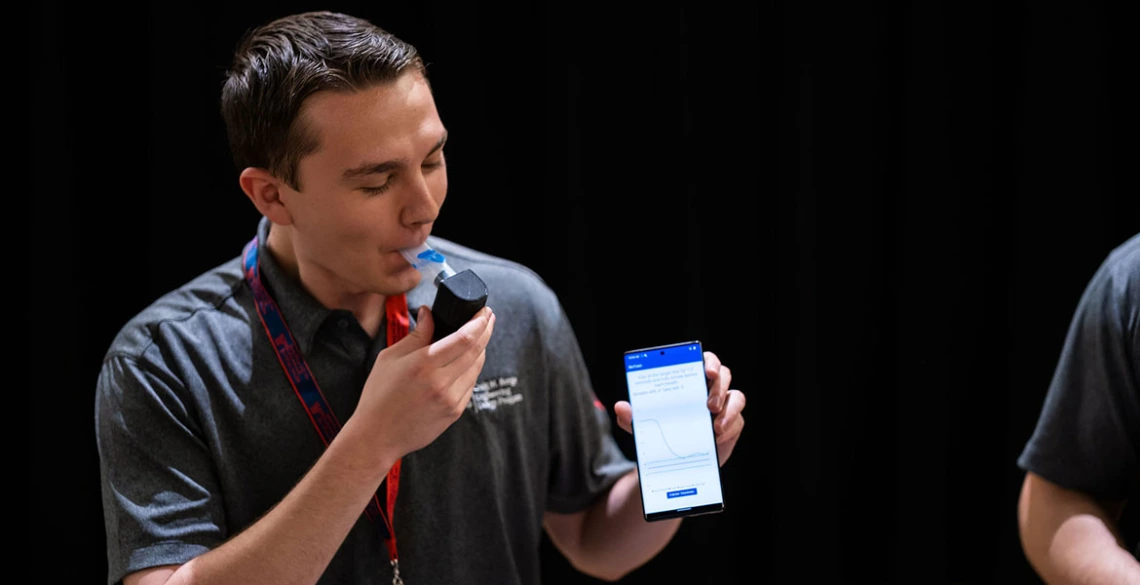Capstone Students Improve Health-Boosting Breathing Device
Breath training could help millions lower blood pressure and reduce the risk of disease.

Capstone team member Nicholas Quatraro demonstrates the Inspiratory Muscle Strength Training (IMST) device at 2023 Craig M. Berge Design Day.
Cardiovascular exercise like running certainly gets you breathing faster, but breathing itself can be its own form of exercise. For its 2023 senior capstone project, a team of five University of Arizona engineering undergrads enhanced a novel breath training device, and now the accompanying regimen is moving toward the market with the potential to improve health for millions of people.
Capstone team 23030 developed an Inspiratory Muscle Strength Training (IMST) device, which patients use to perform breathing exercises that help lower blood pressure and reduce the risk of cardiovascular disease.
The device and its training regimen are designed for older adults; however, this type of training has also been shown to benefit young healthy adults, older adults and adults with a range of health problems, according to sponsor advisor E. Fiona Bailey. The professor of physiology works with the BIO5 Institute.
While many breath training devices exist, the product the student team developed offers accurate pressure sensing and pairs with an app that provides intuitive feedback as it guides users through assessment steps necessary to establish the ideal training plan.
“The students assigned to the project did a fantastic job,” said Bailey.
The students had access to a breathing device Bailey had fabricated in 2012 and to new, commercially available models for comparison. The team was tasked with developing a hand-held design that could store data from at least a month of training sessions, permit download of data and guide the user through the training program.
“The market for respiratory training devices is crowded. However, none of the devices are designed for use by older adults or designed with the objective of lowering blood pressure,” Bailey said. “Accordingly, none of the commercially available devices are designed to offer visual display of the training pressure waveform, the number of training breaths completed and summary statistics.”
Tech Launch Arizona, the UA office that helps commercialize faculty research, filed a provisional patent application for the training regimen Bailey developed for the device. Ideally, Bailey hopes the device-application interface will be assumed by a biomedical company for a community-based clinical trial.
Upgrading a Promising Invention
Bailey originally became interested in this type of device when a then-graduate student in her laboratory, Jennifer Vranish, completed two studies. She showed how just five minutes a day of high-intensity, low-volume IMST significantly lowered blood pressure in adults with obstructive sleep apnea and hypertension.
As a result of this research, Bailey obtained National Institutes of Health funding to run a phase 2 clinical trial on the intervention’s effects on blood pressure and vascular health in older adults with obstructive sleep apnea from 2020 to 2026. As the ongoing trial uses a commercially available training device, users are not provided any visual feedback about their target breath pressure, nor is it possible to upload participants’ training data. Thus, all trial participants must come to campus to download their data and have their training pressures adjusted.
The students’ objective was to mitigate these issues by creating a device that can transmit users' breathing data via Bluetooth to a smartphone app, and which then provides live feedback. Their ergonomic, handheld device contains a one-way breathing valve, requires minimal user interaction and can be disassembled for cleaning. In addition to building a new and user-friendly device, the students designed the critical interactive smartphone application software.
Valuable Career Prep
For Dylan McGuire, a 2023 biomedical engineering graduate and the project’s student team leader, one of the most important lessons he learned was how to delegate responsibilities to keep the project progressing and meet deadlines.
McGuire worked with two additional biomedical engineering majors and two systems engineering majors.
“It was important to utilize all members of the team and direct them according to what each of their strengths were,” McGuire said. “I feel this is a vital skill to have, especially when preparing to enter the workforce.”

